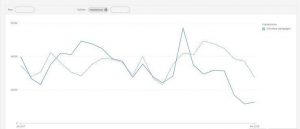CTV 2023: Targeting, Buying Advances, Interactive Leaps, Measurement Morass…
With connected TV/streaming pretty much universally expected to be a prime focus for evolution and advertising investment growth in the year ahead, here are some specific insights and predictions from leading media, ad-tech platform and smart TV OEM executives.
Jess Breslav, chief customer officer, Index Exchange: In 2023, more CTV media owners will unlock the value of contextual targeting — including genre, channel, network, series and TV rating information — to increase transparency for media buyers and curate inventory that matches buyers’ marketing strategies.
The industry undoubtedly needs to continue to innovate to deliver the optimal buying and viewing experience. We’ll see improvements in ad podding. Signaling and standardization will come to fruition and accelerate a shift in media spend in 2023.
With the ecosystem maturing, we’ll also start to see more media buyers take advantage of the full programmatic ecosystem and leverage additional buying models for CTV, such as inventory packages, to scale with confidence. These curated packages give marketers access to exclusive premium inventory while still receiving the benefits and flexibility of the open market.
Hunter Terry, vice president solutions, consulting and CTV commercial lead, Lotame: “Amazed and confused” are the prevailing sentiments around CTV measurement. There will not be a single solution, at least for the time being. In fact, the industry will become even more compartmentalized and disjointed, which will make measurement more difficult. We see it every week when a big streamer or OEM wants to set up its own offering accessible only via its platform. Case in point: Apple just announced they are creating their own DSP specifically to focus on their CTV offering.
Every streaming service is going to try to create its own unique platform. Why? Data. Take LG, for example. They can sell inventory within LG TVs or send the data they collect off into the ecosystem and onto other CTV devices. Any service with customer data is going to package it and sell it — following the example of retail media networks.
Meanwhile, [despite having missed the reach guarantees it gave to some advertisers for its ad-supported launch], Netflix will ultimately surprise everyone with “good advertising.” It’s got the people, pipes and partners to hit it out of the park. Measurement won’t be a stumbling block either, as TV hasn’t done a bang-up job of metrics, and the open web is in disarray.
Will consumers balk? Likely not. Getting a break on price due to ads may be enough of a carrot to stay. With so much original inventory, Netflix has a real advantage, and more runway in global users than newer platforms.
David Wiesenfeld, lead strategist, media and entertainment, TransUnion: Interactive TV will gain a real foothold in 2023. This won’t be the real-time, two-way exchange between viewers and broadcasters that some envision, but producers and distributors are exploring ways to leverage the one-to-one digital nature of streaming TV to allow consumers to respond directly to what they see on the screen.
FuboTV has integrated sports betting into its UI, allowing users to place bets on live games or simply play along and earn points by picking winners, without risking any money. Similar technology could be used to receive other “inputs” from viewers, such as purchase interest in an item worn by a TV character (closing the loop on brand integration) or an opportunity to participate in a game show from your living room.
Lynette Kaylor, senior vice president advertising sales, FuboTV: More than ever, data will be king. As budgets tighten, advertisers will need to become more efficient with their buys and have smart data strategies. Efficiencies come from reducing waste and increasing targeted media buys — investing in the audiences that are most inclined to buy your product or service instead of mass reach. There will also be a greater need for transparent attribution and measurement to show the value of audience-based buys.
First-party data will continue to become increasingly important as more privacy legislation comes into play. Both brands and publishers need to own their relationships with their consumers.
Matt Spiegel, executive vice president, media and entertainment vertical, TransUnion: With more premium services entering the market, consumers will have to choose where to spend their household budgets — and that could propel mid-tier platforms to consolidate.
Thirty-one percent of 2,612 Americans surveyed by Recurly in March planned to cancel some subscription services this year. According to Paymnts.com, between October 2021 and May 2022, the average number of retail product subscriptions among baby boomers and seniors slipped from 2.2 to 2.
Other generations saw steeper drops: Gen Z and Gen X subscriptions fell from 4.9 to 3.6, and millennials’ from 5.6 to 4.7. It is likely they will gravitate toward [cheaper, ad-supported] subscription streaming services as well as free streaming services, making niche players acquisition targets for both upstream and downstream services.
Sean Doherty, CEO, Wurl: Samsung and Roku were the first device makers to embrace FAST (free, ad-supported streaming). Now, many of the top 30 smart TV manufacturers have introduced FAST offerings. I predict that all smart TV manufacturers will go all in with FAST, and we will see nearly 100% device adoption by the end of 2023.
During the 2008 financial crisis, the advertising industry experienced a steep downturn, with one exception: mobile. The smartphone had just hit the market, leading to a steady growth in mobile advertising. Now, as we find ourselves in another economic slump, I predict CTV will persevere in 2023, with growth in connected TV devices more than making up for a decline in ad fill rates.
TV and entertainment appear to be recession-resistant. And with Hulu, Netflix and all the major streamers now offering less expensive versions with ads, there are new, scalable ways for brands to reach lean-back consumers. Smart brands and agencies will realize that the streaming screen is where the eyeballs are.
Frans Vermeulen, vice president strategy and market development, media and entertainment, TransUnion: CTVs are giving smartphones a run for their money. U.S. smartphone time per day is expected to come to three hours and 19 minutes this year. Daily time with connected devices — mainly CTV but also game consoles, set-top boxes such as Roku, Blu-ray players and wearables — will reach one hour and 47 minutes in 2022 and rise to one hour and 57 minutes in 2024.
While CTV ad spending remains much less than that of traditional TV, the gap is closing. This year, U.S. advertisers will spend $18.89 billion on CTV, up 33% over 2021.
(26)
Report Post






